Page created 2 September
2001
EDWARD LAW
ARMS, CRESTS & MONOGRAMS
ORDERS
OF KNIGHTHOOD
Crests are often found with what
appear to be medals depicted hanging below them. Many of these
are actually the badges or jewels of British orders of knighthood.
Whilst most people will be aware of the Order of the Bath and
that of the Garter, there are others less well known: Order of
the Thistle; Order of St Patrick; Order of St Michael and St
George; Order of the Star of India; Order of the Indian Empire.
 There are quite a
number of crests with 2 and 3 badges appended; the one shown here
with 4 is exceptional. All the badges etc. are different and
theoretically it should be possible to identify the order
depicted. However, the badges or jewels are very small and many
have eluded identification. The Most Honourable Order of the Bath,
one of the better known orders, creates particular problems with
its variety of classes: 1st, 2nd, 3rd, military, and civil.
There are quite a
number of crests with 2 and 3 badges appended; the one shown here
with 4 is exceptional. All the badges etc. are different and
theoretically it should be possible to identify the order
depicted. However, the badges or jewels are very small and many
have eluded identification. The Most Honourable Order of the Bath,
one of the better known orders, creates particular problems with
its variety of classes: 1st, 2nd, 3rd, military, and civil.
The four illustrations above, from
a set of British Orders: all relate to The Most Honourable Order
of the Bath and carry the motto of the orderTria juncta in
uno. They are, from left to right, the civil & 
 diplomatic badge, the star of the knights
grand cross, the badge of the military section and the star of
the military knights commanders. The two crests at the sides also
relate to the order of the Bath, with personal crests enclosed by
the motto of the order. That on the right is of a baronet,
distinguished by the badge (red hand) of Ulster.
diplomatic badge, the star of the knights
grand cross, the badge of the military section and the star of
the military knights commanders. The two crests at the sides also
relate to the order of the Bath, with personal crests enclosed by
the motto of the order. That on the right is of a baronet,
distinguished by the badge (red hand) of Ulster.
When individuals can be identified
from their arms or crests then their honours can often be found  from biographical details of knights
included in Peerages and Baronetages of the period. This page
does not set out to give a definitive account of the orders, most
of the Peerages carry sections on them with illustrations of
their regalia, origins, officers, numbers of members, and
occasionally listings of members by name at a particular date. An
order which does not receive wide coverage is the Royal
Hanoverian Guelphic Order: shown here is the collar and badge of
the Order on the crest of the Earl of Wilton.
from biographical details of knights
included in Peerages and Baronetages of the period. This page
does not set out to give a definitive account of the orders, most
of the Peerages carry sections on them with illustrations of
their regalia, origins, officers, numbers of members, and
occasionally listings of members by name at a particular date. An
order which does not receive wide coverage is the Royal
Hanoverian Guelphic Order: shown here is the collar and badge of
the Order on the crest of the Earl of Wilton.
The magnificent armorials shown
here, in a very opulent execution, are those of Sir William
Wellington  Cairns, KCMG, and illustrate some of the
etiquette in displaying the order to which an individual belonged.
Cairns was created a Companion of the Order of St Michael and St
George (CMG) in 1874 and a Knight Commander (KCMG) 3 years later.
The display here with his personal arms encircled by the motto of
the Order, Auspicium melioris ævi, and with the badge
pendant was executed after his elevation. As a companion he would
have displayed only the fourteen point badge. The highest
division of the order, Knights Grand Cross (GCMG) were
additionally entitled to display the collar of the order.
Cairns, KCMG, and illustrate some of the
etiquette in displaying the order to which an individual belonged.
Cairns was created a Companion of the Order of St Michael and St
George (CMG) in 1874 and a Knight Commander (KCMG) 3 years later.
The display here with his personal arms encircled by the motto of
the Order, Auspicium melioris ævi, and with the badge
pendant was executed after his elevation. As a companion he would
have displayed only the fourteen point badge. The highest
division of the order, Knights Grand Cross (GCMG) were
additionally entitled to display the collar of the order.
The origins of the handsome collar
(Right) are not known. The SS collar is Lancastrian (the central
rose may be an allusion to the red rose of that county) and in
the Victorian era was still worn by the Heralds, the Lord Mayor
of London and certain judges.
I have only located one set of crests
depicting British orders which is a little surprising, four of
these relating to the Order of the Bath are shown above and the
two shown here are the star (left) and the 
 badge (right) of The Most Illustrious Order
of St Patrick. They carry the date, 1783, of the institution of
the Order and its motto, Quis separabit.
badge (right) of The Most Illustrious Order
of St Patrick. They carry the date, 1783, of the institution of
the Order and its motto, Quis separabit.
The paucity of this set may be because there
were sets of scraps of British and Foreign orders which are quite
attractive and are two or three times the size of the average
crest: they are found relatively often in crest albums.
 |
Left:
A nice depiction of the badge of The Most Eminent Order
of the Indian Empire. The letters of India appearing in
the petals. Surmounted by a personal crest.
|
Right:
The crest of General Frederick Edward Chapman, GCB. The
badges probably the Order of the Bath, Legion of Honour
and 3rd Class Medjidie.
|
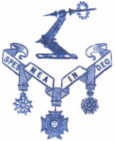 |
Right:
The arms, supporters and motto of Baron Lurgan, with the
collar and badge of The Most Illustrious Order of St
Patrick.
|
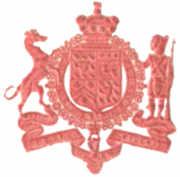 |
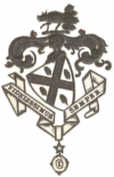 |
Left:
Armorial display with badge of The Most Exalted Order of
the Star of India. The arms and crest probably of Lieut-Gen.
Richard Harte Keatinge.
|
Return to HOME
PAGE
or to TOPICS
PAGE to view further pages.
 There are quite a
number of crests with 2 and 3 badges appended; the one shown here
with 4 is exceptional. All the badges etc. are different and
theoretically it should be possible to identify the order
depicted. However, the badges or jewels are very small and many
have eluded identification. The Most Honourable Order of the Bath,
one of the better known orders, creates particular problems with
its variety of classes: 1st, 2nd, 3rd, military, and civil.
There are quite a
number of crests with 2 and 3 badges appended; the one shown here
with 4 is exceptional. All the badges etc. are different and
theoretically it should be possible to identify the order
depicted. However, the badges or jewels are very small and many
have eluded identification. The Most Honourable Order of the Bath,
one of the better known orders, creates particular problems with
its variety of classes: 1st, 2nd, 3rd, military, and civil.

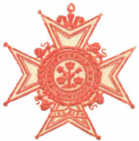
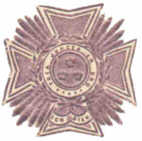

 diplomatic badge, the star of the knights
grand cross, the badge of the military section and the star of
the military knights commanders. The two crests at the sides also
relate to the order of the Bath, with personal crests enclosed by
the motto of the order. That on the right is of a baronet,
distinguished by the badge (red hand) of Ulster.
diplomatic badge, the star of the knights
grand cross, the badge of the military section and the star of
the military knights commanders. The two crests at the sides also
relate to the order of the Bath, with personal crests enclosed by
the motto of the order. That on the right is of a baronet,
distinguished by the badge (red hand) of Ulster. from biographical details of knights
included in Peerages and Baronetages of the period. This page
does not set out to give a definitive account of the orders, most
of the Peerages carry sections on them with illustrations of
their regalia, origins, officers, numbers of members, and
occasionally listings of members by name at a particular date. An
order which does not receive wide coverage is the Royal
Hanoverian Guelphic Order: shown here is the collar and badge of
the Order on the crest of the Earl of Wilton.
from biographical details of knights
included in Peerages and Baronetages of the period. This page
does not set out to give a definitive account of the orders, most
of the Peerages carry sections on them with illustrations of
their regalia, origins, officers, numbers of members, and
occasionally listings of members by name at a particular date. An
order which does not receive wide coverage is the Royal
Hanoverian Guelphic Order: shown here is the collar and badge of
the Order on the crest of the Earl of Wilton.  Cairns, KCMG, and illustrate some of the
etiquette in displaying the order to which an individual belonged.
Cairns was created a Companion of the Order of St Michael and St
George (CMG) in 1874 and a Knight Commander (KCMG) 3 years later.
The display here with his personal arms encircled by the motto of
the Order, Auspicium melioris ævi, and with the badge
pendant was executed after his elevation. As a companion he would
have displayed only the fourteen point badge. The highest
division of the order, Knights Grand Cross (GCMG) were
additionally entitled to display the collar of the order.
Cairns, KCMG, and illustrate some of the
etiquette in displaying the order to which an individual belonged.
Cairns was created a Companion of the Order of St Michael and St
George (CMG) in 1874 and a Knight Commander (KCMG) 3 years later.
The display here with his personal arms encircled by the motto of
the Order, Auspicium melioris ævi, and with the badge
pendant was executed after his elevation. As a companion he would
have displayed only the fourteen point badge. The highest
division of the order, Knights Grand Cross (GCMG) were
additionally entitled to display the collar of the order.

 badge (right) of The Most Illustrious Order
of St Patrick. They carry the date, 1783, of the institution of
the Order and its motto, Quis separabit.
badge (right) of The Most Illustrious Order
of St Patrick. They carry the date, 1783, of the institution of
the Order and its motto, Quis separabit.


